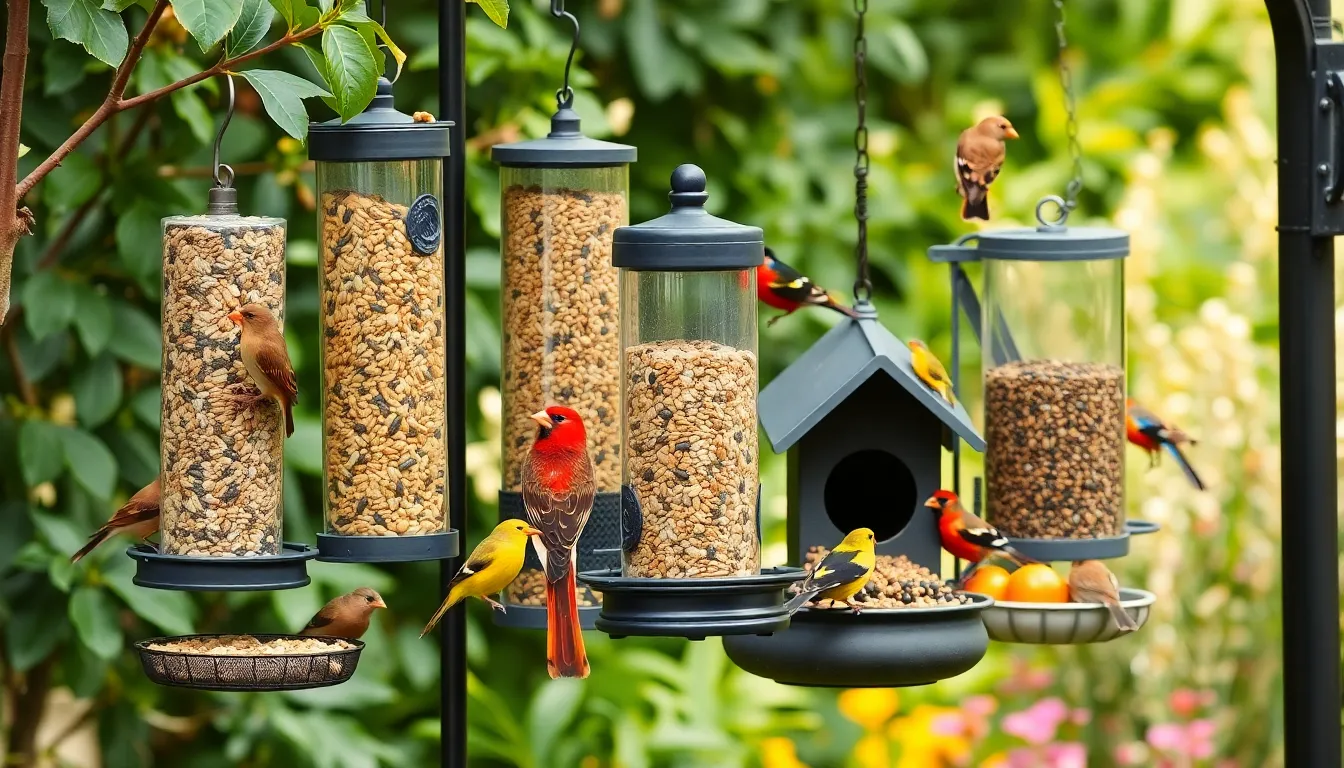Table of Contents
ToggleImagine transforming your backyard into a lively avian hotspot, where feathered friends flock to your bird feeder like it’s the hottest café in town. Attracting birds isn’t just about tossing some seeds out and hoping for the best. It’s an art, a science, and a little bit of magic that turns your outdoor space into a vibrant sanctuary.
Choosing the Right Bird Feeder
Selecting a suitable bird feeder enhances the likelihood of attracting a diverse array of birds to the backyard. Feeder choice affects bird species, feeding habits, and overall enjoyment.
Types of Feeders
Different feeders cater to various bird species and seed types. Tube feeders accommodate small seeds like thistle and sunflower. Platform feeders attract ground-feeding birds such as sparrows and juncos. Hummingbird feeders, filled with a sugar-water solution, invite vibrant hummingbirds. Suet feeders offer high-energy options, attracting woodpeckers and other insect-eating birds. Each type serves a distinct purpose, helping in providing an ideal feeding environment.
Feeder Materials
Materials significantly impact feeder durability and ease of cleaning. Metal feeders resist squirrel damage and prevent weather-related wear. Plastic feeders are lightweight and often come in eye-catching designs, making them easy to hung. Glass feeders, while delicate, allow for attractive displays and easy monitoring of seed levels. Wood feeders, although charming, require regular maintenance to withstand moisture. Choosing the right material contributes to long-term bird feeding success.
Selecting the Best Bird Food

Choosing the right bird food plays a crucial role in attracting a variety of bird species. He or she must consider different seed types and additional food options to create an appealing environment.
Seed Varieties
Sunflower seeds attract numerous birds, including cardinals and finches. Nyjer seeds specifically draw goldfinches to feeders. Safflower seeds entice doves and sparrows while deterring unwanted species. A mix of seeds offers a diverse menu, appealing to ground-feeding and tree-dwelling birds alike. Specific blends designed for local bird populations enhance chances of attracting the desired visitors.
Additional Food Options
Suet provides high-energy nutrition, especially beneficial during winter months. Fruits like apples and berries attract various species, including orioles and robins. Mealworms serve as a protein-rich treat for wrens and bluebirds. Offering a mix of fresh food options alongside seeds creates a more inviting atmosphere. Nectar in hummingbird feeders entices vibrant hummingbirds and promotes frequent visits.
Choosing a Suitable Location
Selecting the right location for a bird feeder significantly impacts its effectiveness in attracting birds.
Sunlight and Shelter
Consider placing the feeder in a spot that receives both sunlight and shelter. Birds prefer locations where they can bask in the sun while also having nearby cover for protection against predators. Morning sun encourages feeding and provides warmth, especially in cooler climates. Positioning the feeder near trees or shrubs offers birds a safe retreat. This combination enhances visibility and accessibility, encouraging frequent visits by various species.
Height and Distance from Obstacles
Position the feeder at least five feet off the ground for optimal access. Heights help birds feel secure while feeding. Additionally, keeping the feeder away from obstructions, such as branches or fences, reduces the chance of collisions. Ideally, maintain a distance of 10 to 15 feet from structures like windows where birds might fly into danger. Ample space around the feeder invites more birds to land without hesitation.
Maintenance and Cleaning
Regular maintenance and cleaning keep feeders in top condition, ensuring a safe and appealing environment for birds.
Regular Food Refills
Refilling bird feeders consistently prevents food shortages and maintains high interest among avian visitors. Fresh seeds attract birds more effectively than stale ones, so aiming for a bi-weekly refill schedule encourages frequent visits. Additionally, observing bird activity helps determine peak feeding times, allowing for strategic refills. As feeders empty, birds may seek alternative food sources, leading to decreased visits.
Cleaning Procedures
Cleaning bird feeders is essential for maintaining hygiene and attracting healthy birds. A routine cleaning every two weeks aids in preventing mold and disease buildup. Using a mixture of warm water and mild soap removes residue effectively. Rinsing thoroughly ensures no soap residue remains, as birds are sensitive to chemicals. Allowing feeders to dry completely before refilling enhances their appeal. Implementing these cleaning practices promotes a thriving bird-friendly environment.
Attracting a Diverse Range of Birds
Attracting a varied selection of birds enhances the enjoyment of any backyard sanctuary. Two key strategies involve planting native flora and adding water sources.
Planting Native Flora
Choosing native plants creates an inviting environment for local birds. Native species provide essential food sources and shelter, supporting diverse avian populations. Perennials and shrubs offer seeds and berries that cater to various birds, including cardinals and sparrows. Sunflowers, coneflowers, and wildflowers attract visually striking species such as goldfinches and hummingbirds. Incorporating plants that bloom in different seasons ensures a consistent food supply throughout the year. Additionally, native plants require less maintenance, further benefiting bird enthusiasts.
Adding Water Sources
Water sources play a crucial role in attracting birds, offering essential hydration and bathing opportunities. Bird baths should be shallow to accommodate different species safely. Adding a fountain or dripper can entice birds with the sounds of moving water. Positioning water features near feeders encourages feathered visitors to frequent the area. Changing the water daily maintains cleanliness and promotes a safe drinking environment. Providing a variety of water sources ensures that different birds can hydrate and socialize, enriching the birdwatching experience.
Creating a bird-friendly backyard is a rewarding endeavor that enriches both the environment and the observer’s experience. By thoughtfully selecting feeders and food options while ensuring a safe and inviting space, anyone can attract a diverse range of birds. Incorporating native plants and water sources further enhances the habitat, promoting a vibrant ecosystem. Regular maintenance and a commitment to cleanliness will ensure that the feeders remain a reliable source of nourishment. With these strategies, birdwatchers can enjoy the beauty and joy that comes from welcoming feathered visitors into their outdoor space.










